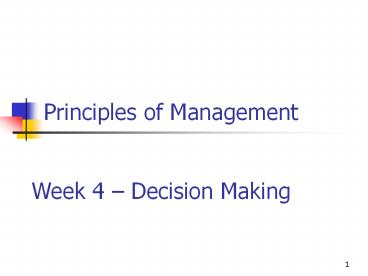Principles of Management - PowerPoint PPT Presentation
1 / 22
Title:
Principles of Management
Description:
Acer 4 3 4 3 2 6. Compaq 3 4 5 2 6 7. Gateway 9 6 7 7 8 2. HP 3 5 6 7 6 5. Micromedia 2 2 3 4 5 4 ... Acer 125. Compaq 142. Gateway 246. HP 174. Micromedia 103 ... – PowerPoint PPT presentation
Number of Views:1698
Avg rating:3.0/5.0
Title: Principles of Management
1
Principles of Management
Week 4 Decision Making
2
Rational Decision Making 8-step Process
- 1. Identification of problem
- 2. Identification of Decision Criteria
- 3. Allocation of weights to criteria
- 4. Development of alternatives
- 5. Analysis of alternatives
- 6. Decide on an alternative
- 7. Implementation of decision
- 8. Evaluation of decision
3
The Decision-Making Process
Allocation of Weights to Criteria
Problem Identification
Identification of Decision Criteria
Development of Alternatives
Acer Compaq Gateway HP Micromedia NEC Sony Toshiba
My salespeople need new computers
Price Weight Warranty Screen type Reliability Scre
en size
Reliability 10 Screen size 8 Warranty
5 Weight 5 Price
4 Screen type 3
Implementation of an Alternative
Analysis of Alternatives
Selection of an Alternative
R S W W P S Acer 4 3 4 3 2 6 Compaq 3 4
5 2 6 7 Gateway 9 6 7 7 8 2 HP 3 5 6
7 6 5 Micromedia 2 2 3 4 5 4 NEC 3 4 5
6 7 2 Sony 7 5 6 4 2 8 Toshiba 3 4 5 6
7 3
Acer 125 Compaq 142 Gateway 246 HP 174 Microme
dia 103 NEC 151 Sony 192 Toshiba 154
Gateway
Evaluation of Decision Effectiveness
4
Decisions in the Management Functions
5
About Rational Decision Making
- Is it always possible to make rational decisions?
6
Single, well- defined goal is to be achieved
Problem is clear and unambiguous
All alternatives and consequences are known
Rational Decision Making
Preferences are clear
Final choice will maximize payoff
Preferences are constant and stable
No time or cost constraints exist
7
Bounded Rationality
- behave rationally within the parameters of a
simplified decision-making process that is
limited by an individuals ability to process
information - satisfice - accept solutions that are good
enough
8
Intuitive decision making
- Based on gut feeling
- subconscious process of making decisions on the
basis of experience, values, and emotions - does not rely on a systematic or thorough
analysis of the problem - generally complements a rational analysis
9
Types of Problems Decisions
- Well-Structured Problems - straightforward,
familiar, and easily defined - Programmed Decisions - used to address structured
problems - minimize the need for managers to use discretion
- facilitate organizational efficiency
10
Types of Problems and Decisions
- Poorly-Structured Problems - new, unusual
problems for which information is ambiguous or
incomplete - Nonprogrammed Decisions - used to address poorly-
structured problems - produce a custom-made response
- more frequent among higher-level managers
- Procedure, Rule, Policy
11
Types of Problems Level In the Organization
Programmed Decisions
Nonprogrammed Decisions
12
Things to consider . . .
- Certainty how certain is a particular outcome?
- Risk how much risk can you take?
- expected value - the conditional return from each
possible outcome - Uncertainty Limited information prevents
estimation of outcome probabilities for
alternatives.
13
Expected Value for Revenues from the Addition of
One Ski Lift
14
What to do?
- maximax choice optimistic
- maximizing the maximum possible payoff
- taking the best of all possible cases
- maximin choice pessimistic
- maximizing the minimum possible payoff
- taking the best of the worst cases
- minimax - minimize the maximum regret
(difference between what you get and the best
case)
15
Payoff Matrix
16
Regret Matrix
17
Decision-Making Styles
- Dimensions of Decision-Making Styles
- Value orientations
- Task and technical concerns
- People and social concerns
- Tolerance for ambiguity
- Low tolerance require consistency and order
- High tolerance multiple thoughts simultaneously
18
Decision-Making Styles
- Directive
- Prefer simple,
- clear solutions
- Make decisions
- rapidly
- Do not consider
- many alternatives
- Rely on existing
- rules
- Conceptual
- Socially oriented
- Humanistic and
- artistic approach
- Solve problems
- creatively
- Enjoy new ideas
- Behavioral
- Concern for their
- organization
- Interest in helping
- others
- Open to
- suggestions
- Rely on meetings
19
Decision Making Styles
High
Analytical
Conceptual
Directive
Behavioral
Tolerance for Ambiguity
Low
Tasks and TechnicalConcerns
People and SocialConcerns
Value Orientation
20
Common Errors in Decision Making
- Over-confidence
- Hindsight
- Self-serving
- Sunk costs
- Randomness
- Representation
- Availability
- Framing
- Confirmation
- Selective perception
- Anchoring
- Immediate gratification
21
Advantages and Disadvantages of Group-Aided
Decision Making
Advantages
Disadvantages
- 1. Greater pool of knowledge 1. Social pressure
- 2. Different perspectives 2. Minority
domination - 3. Greater comprehension 3. Logrolling
- 4. Increased acceptance 4. Goal displacement
- 5. Training ground 5. Groupthink
22
Decision-Making Process































